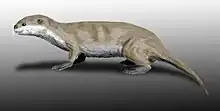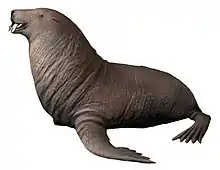| Frisiphoca Temporal range: | |
|---|---|
| Scientific classification | |
| Domain: | Eukaryota |
| Kingdom: | Animalia |
| Phylum: | Chordata |
| Class: | Mammalia |
| Order: | Carnivora |
| Clade: | Pinnipedia |
| Family: | Phocidae |
| Subfamily: | Phocinae |
| Genus: | †Frisiphoca Dewaele, Lambert, and Louwye, 2018 |
| Species | |
| |
Frisiphoca is an extinct genus of phocid belonging to the subfamily Phocinae. It is known from fossils found in the late Miocene of Belgium.
Taxonomy
There are two species of Frisiphoca, F. aberratum and F. affine. Both were previously assigned to Monotherium,[1] but Dewaele et al. (2018) found those species generically distinct from the Monotherium type species and placed them in their own genus, Frisiphoca.[2]
Fossils
Fossils of Frisiphoca aberratum and F. affine occur in the Tortonian-age Diest Formation of the vicinity of Antwerp, Belgium.[1] Ray (1976) tentatively referred to F. aberratum a humerus from Martha's Vineyard, Massachusetts.[3]
References
- 1 2 P. J. Van Beneden. 1876. Les phoques fossiles du bassin d'Anvers. Bulletins de l'Academie Royale des Sciences, des Lettres et des Beaux-Arts de Belgique 41:783-803
- ↑ Leonard Dewaele; Olivier Lambert; Stephen Louwye (2018). "A critical revision of the fossil record, stratigraphy and diversity of the Neogene seal genus Monotherium (Carnivora, Phocidae)". Royal Society Open Science. 5 (5): 171669. doi:10.1098/rsos.171669.
- ↑ C. E. Ray. 1976. Phoca wymani and other Tertiary seals (Mammalia: Phocidae) described from the eastern seaboard of North America. Smithsonian Contributions to Paleobiology 28:1-33.
This article is issued from Wikipedia. The text is licensed under Creative Commons - Attribution - Sharealike. Additional terms may apply for the media files.



